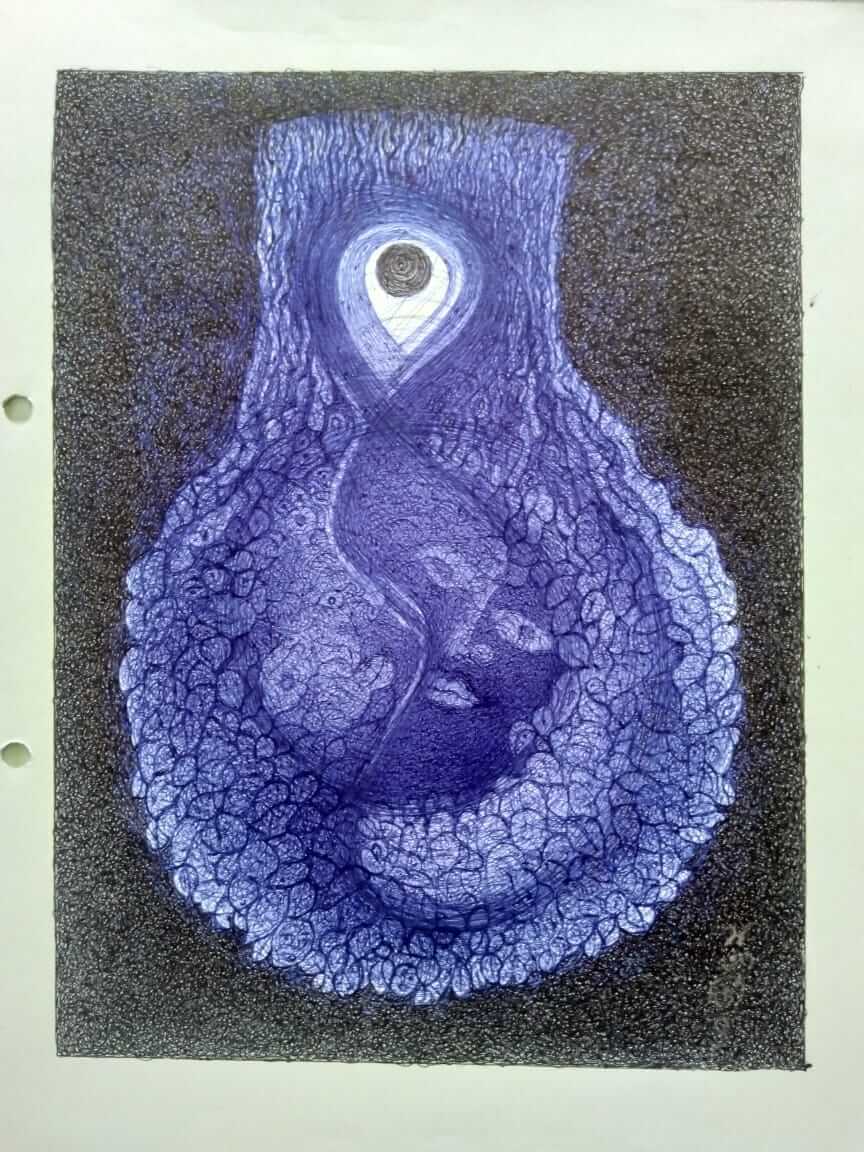Nilanjana retells the stories from the Srimad Bhagavatam, bringing alive the essential Indian wisdom of the yore. In the third part of the narrative, she tells us about the curse on Parikshit, caused by his rashness. The good king, in a fit of frustration, put the skin of a dead snake around the neck of the great sage, Shamika, whose young son cursed Parikshit. The sage was sad. Parikshit realized his folly. It was too late. He gave away his wealth and waited at the banks of Ganga for the curse to fructify. Many sages congregated to discuss how to mitigate the curse. Find out more about this, in the weekly column, exclusively in Different Truths.
After the battle of Kurushetra between the Pandavas and the Kauravas, Duryodhana (the Kaurava monarch) was on his deathbed in immense pain. His thigh was brutally broken by Bhima. Bhima had promised his wife Draupadi that he would avenge the insult meted out to her by Duryodhana. Ashvatthama, the son of Drona (the guru or spiritual guide of the Kauravas and Pandavas) was angry at the sight and took a pledge to avenge the death of his king.
At night when everybody was fast asleep, Ashvattama set the Pandava camp on fire. The sons of Draupadi and her brothers got killed.
 Draupadi was struck with grief. Arjuna tried to comfort her and pledged to bring the head of the sinner who caused such misery. Arjuna along with his charioteer, Krishna, chased Ashvattama. To save himself Ashvattama invoked the Brahma-astra (the ultimate weapon usually invoked by a special chant, for a specific purpose) with the intention, “Let the world be Pandava-less!”
Draupadi was struck with grief. Arjuna tried to comfort her and pledged to bring the head of the sinner who caused such misery. Arjuna along with his charioteer, Krishna, chased Ashvattama. To save himself Ashvattama invoked the Brahma-astra (the ultimate weapon usually invoked by a special chant, for a specific purpose) with the intention, “Let the world be Pandava-less!”
Arjuna invoked the same weapon as well. The wise ones were very worried since the fire that was likely to be caused by the collision of these two weapons was deadly enough to destroy the world. They requested both to withdraw their weapons.
Arjuna obeyed, but Ashvattama could not. His sins had made him impotent against his own weapons. Afraid that the weapon would destroy him, he redirected it towards the unborn child of the Pandavas (Arjuna’s grandson).
 Arjuna dragged Ashvattama to Draupadi. He was the only son of his guru (spiritual guide), his playmate so Arjuna could not bring himself to kill Ashvattama. Draupadi’s sorrow was inconsolable, but her anger had diminished. She asked Arjuna to let Ashvattama go. She said that she understood how it is to lose your children and she would not wish to inflict that pain on anybody else, especially Ashvattama’s mother. She had just lost her husband and he was her only son. Bhima was angry and was not willing to release Ashvattama. To strike a balance, Arjuna chopped off the jewel from Ashvattama’s head and let him go.
Arjuna dragged Ashvattama to Draupadi. He was the only son of his guru (spiritual guide), his playmate so Arjuna could not bring himself to kill Ashvattama. Draupadi’s sorrow was inconsolable, but her anger had diminished. She asked Arjuna to let Ashvattama go. She said that she understood how it is to lose your children and she would not wish to inflict that pain on anybody else, especially Ashvattama’s mother. She had just lost her husband and he was her only son. Bhima was angry and was not willing to release Ashvattama. To strike a balance, Arjuna chopped off the jewel from Ashvattama’s head and let him go.
Arjuna’s son Abhimanyu was slain in the battlefield. His wife, Uttara, was expecting their child. The child, inside the womb, could experience the fire emanating from the Brahma-astra that was re-directed towards him. He felt that he would be burnt and was very scared. Suddenly, he saw another form as big as a thumb with a golden crown on his head. His body had a blue sheen, his dress was the colour of lighting, he had four arms and his eyes exuded crimson anger. The mace in his hand was spittin g fire and he was twirling it around the Brahma-astra. For months, he stayed inside the womb of Uttara and subdued the power of the deadly Brahma-astra. As the full grown child looked on, he disappeared from the womb.
g fire and he was twirling it around the Brahma-astra. For months, he stayed inside the womb of Uttara and subdued the power of the deadly Brahma-astra. As the full grown child looked on, he disappeared from the womb.
The child, when born, was named Parikshit. When Parikshit matured into an able youth, the Pandavas handed over the kingdom to him and left for the Himalayas. Parikshit was an able .ruler and the kingdom flourished under him.
One day when Parikshit had gone out for hunting, he had a particularly long and tiring day. Hungry, thirsty and fatigued he wandered around. Finally, he spotted n ashrama (hermitage) around the corner and went there for food and water. Nobody, however, answered his calls. As he kept walking around he saw a rishi (sage) immersed in deep meditation, oblivious of the world around. The king asked him for water. Repeated requests received no response. Angered by this indifference, with his ego bruised, Parikshit lifted the skin of a dead snake lying around and placed it on the neck of the sage.
Shamika, the great sage, was still unaware as the king walked away.
Shringi, the young son of Shamika, was told about this event by his playmates. In a fit of anger, he cursed the king, “A week from today the dreaded snake Takshaka’s sting will be the cause of his death.”
Shringi’s wail brought his father out of his trance. The wise sage enquired about the cause of such an untimely wail. Shringi narrated the incident only to be condemned by his father, “You have been too rash. You should learn how to restrain yourself. Parikshit is a righteous king, an able ruler and he was just a little childish in this act. This childishness cannot be the reason for such a deadly curse. You have to leave this place and perform penance till you learn self-control. Now, let me warn the king and give him a chance to prepare for the other world.”
Meanwhile, the king returned to his palace. He realised his stupidity and wondered what to do about it. Meanwhile, Shamika’s obedient disciple Gauramukh had already arrived in the king’s palace and requested audience with Parikshit. He informed the king of the curse –he had only seven more days to live.
Parikshit remained unperturbed at this emergency since he thought that he was befittingly punished. He calmly handed over his kingdom to his son Janamejaya. He donated all his wealth, renounced his royal palace and prepared himself to welcome death.
Once he reached the banks of the sacred river Ganga, he decided to meditate on the holy Kusha (another name for darba grass that is often used in religious ceremonies) grass and decided on Prayopavesha (fasting to death with thoughts focussed on the divine). Great sages assembled by his side – Atri, Vasistha, Chyavana, Sharadvan, Bhrigu, Angiras, Parashara, Vishwamitra, Parashurama, Vyasa and Narada.
Parikshit was very happy, “I am so lucky to be encircled by such enlightened company in my last days. I am eager to welcome death. I just have one question…”
 The king paused and asked, “How does someone who is so close to death, go about washing away all accumulated sins?”
The king paused and asked, “How does someone who is so close to death, go about washing away all accumulated sins?”
The wise sages discussed; some spoke of yajna (a ritual or ceremony where oblations are offered to the Divine), others of yoga (in this context, it refers to deep meditation that unites one with the divine spirit), some mentioned tapas (penance), while others spoke of dana (charity). There seemed to be no definite answer. All paths would lead to the divine, but the king had limited time. Seven days was not enough for any of these paths. In any case, he had donated everything already, while he left his kingdom. The other three suggestions would take longer time than what the king had…
[To be continued]
Footnote: Srimad Bhagavatam is often called the Bhagavad Purana. Authored by Ved Vyasa, the stories are about the various avatars (incarnations) of Lord Vishnu, also known as Narayana.
©Nilanjana Dey
Photo from the internet.



 By
By
 By
By
